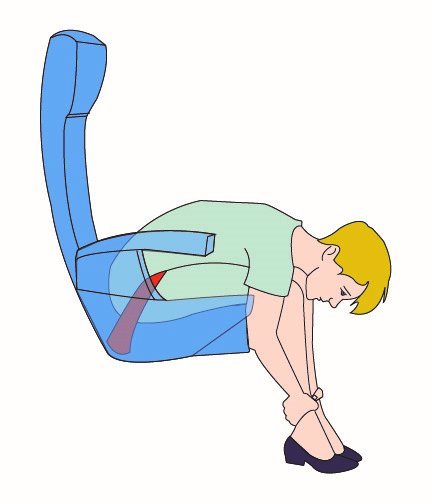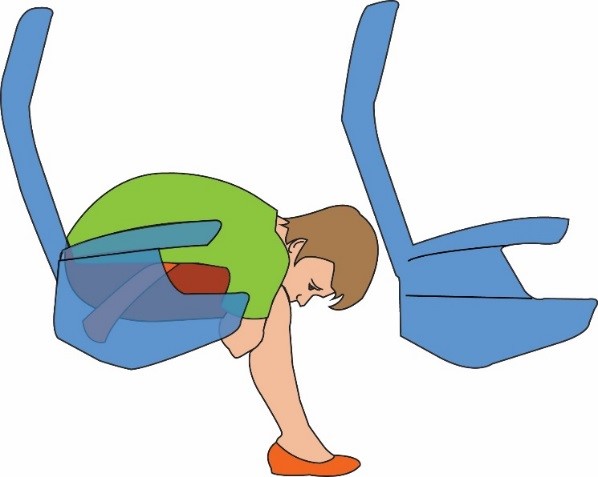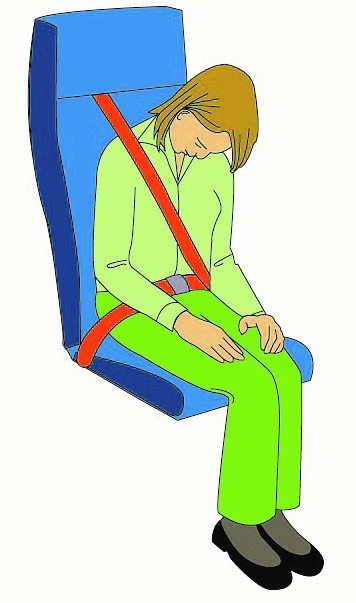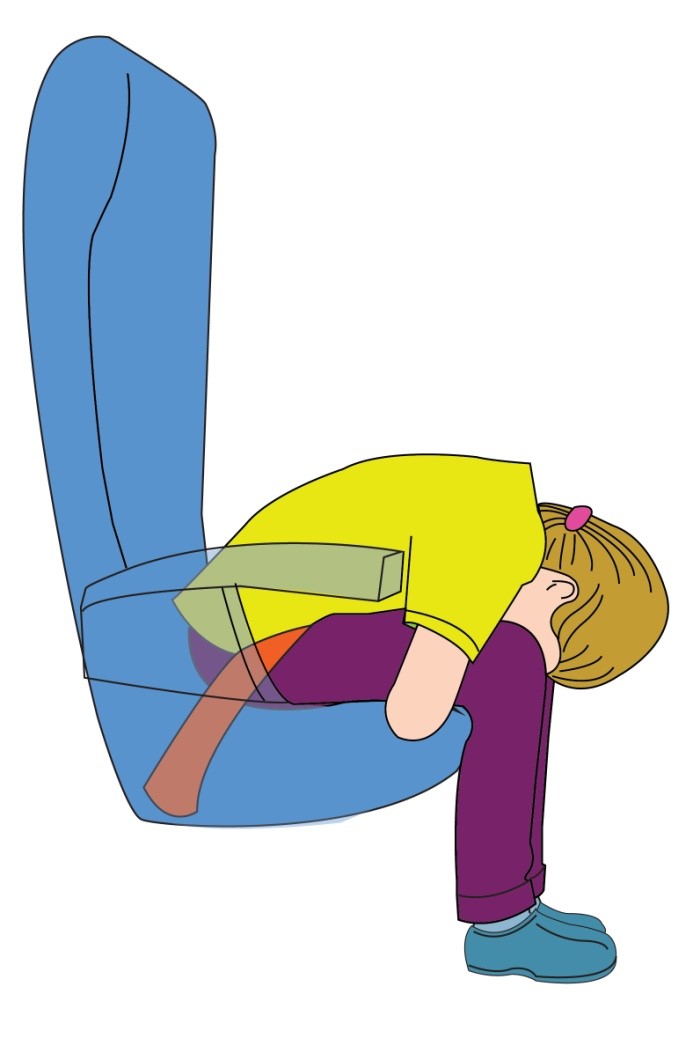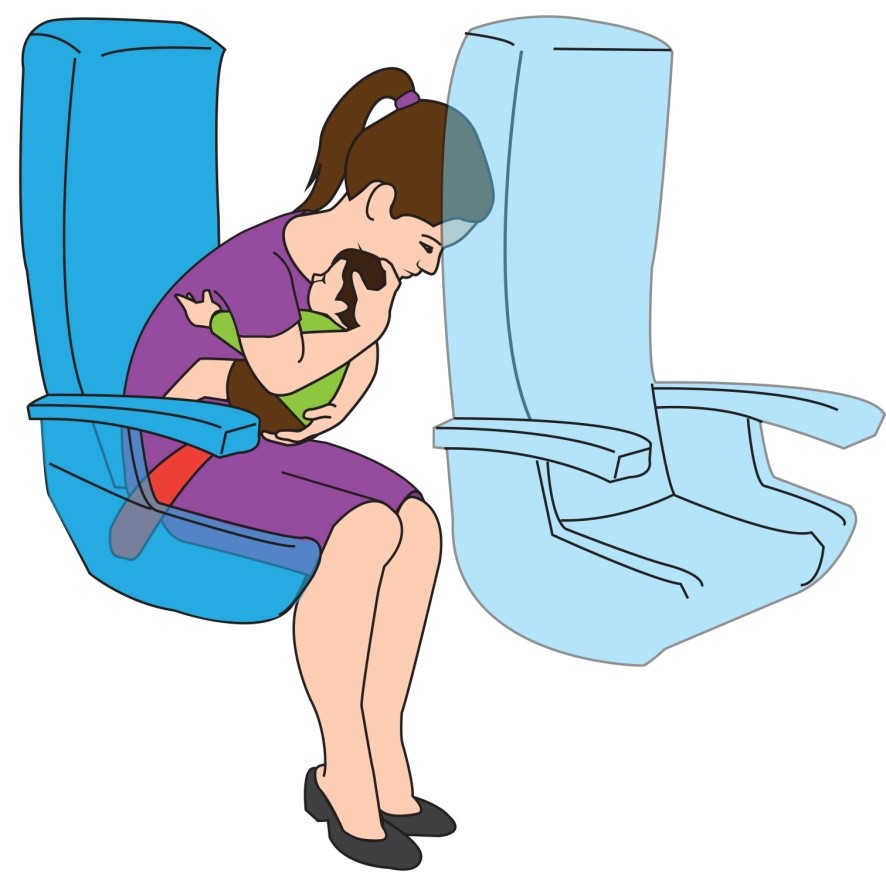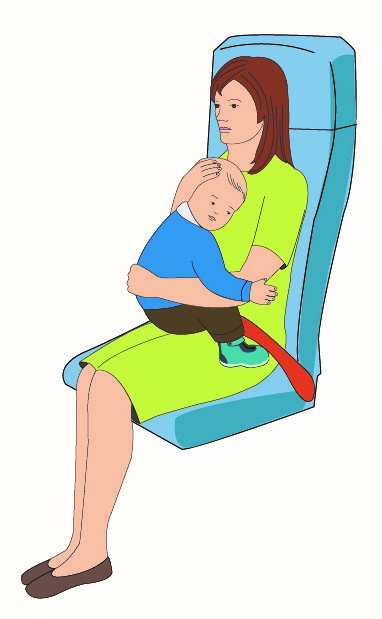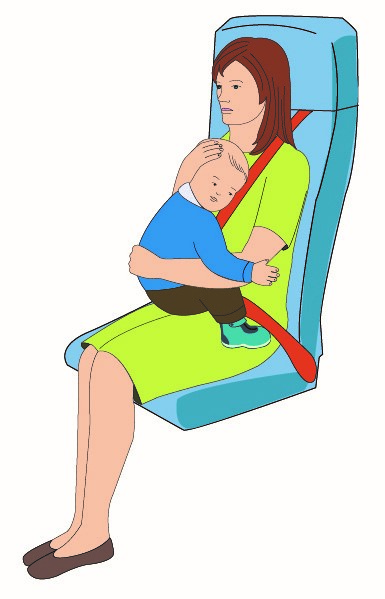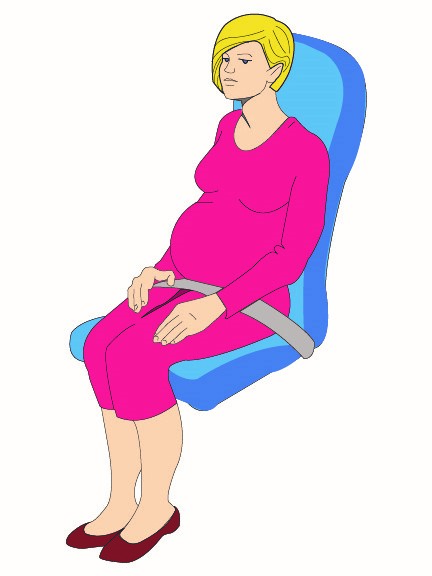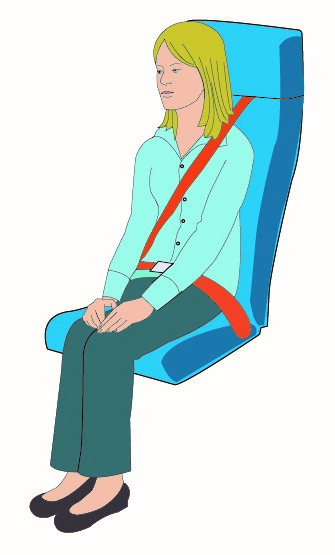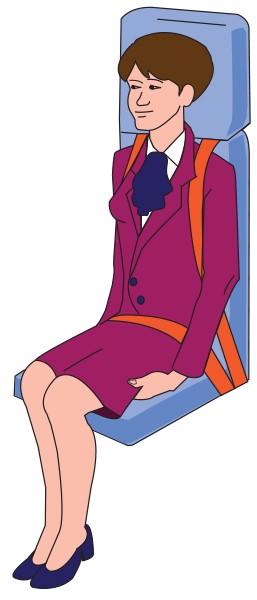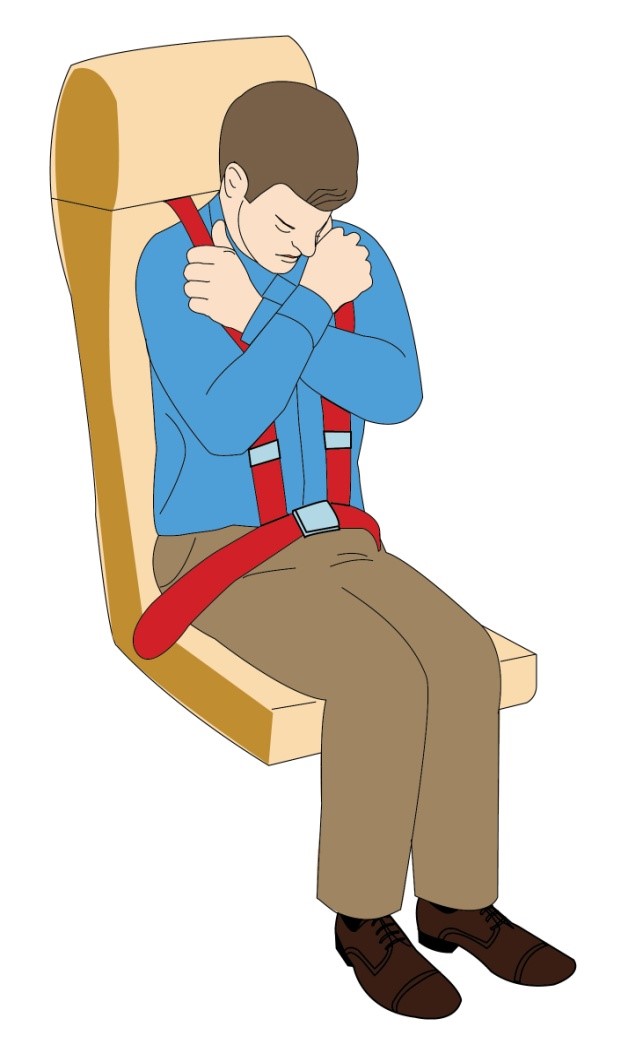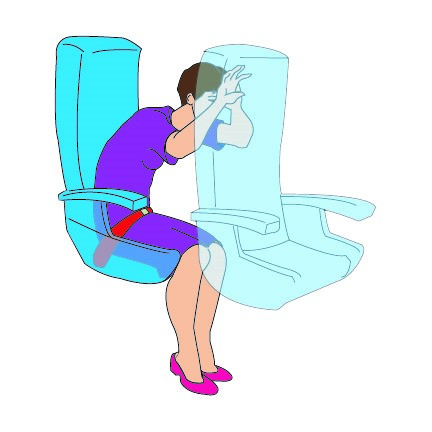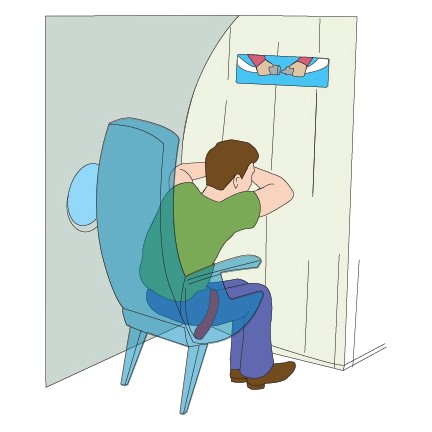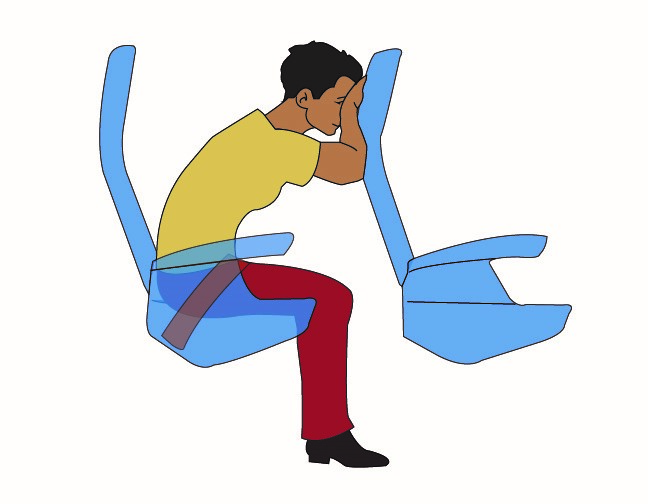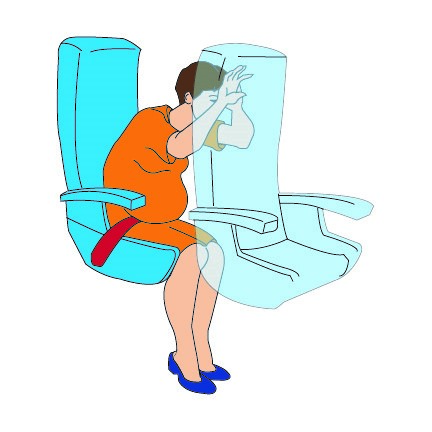Brace for Impact Positions for all Aircraft Occupants
| Issuing Office: | Standards Branch |
|---|---|
| File Classification No. : | Z 5000-34 |
| RDIMS No. : | 8521419-V12 |
| Document No. : | AC 700-036 |
| Issue No. : | 01 |
| Effective Date: | 2016-09-30 |
Table of Contents
- 1.0 INTRODUCTION
- 2.0 REFERENCES AND REQUIREMENTS
- 3.0 BACKGROUND
- 4.0 PASSENGER AND CREW MEMBER BRACE POSITIONS
- 4.1 General Brace Position Instructions for Passenger and Crew Members
- 4.2 Forward-facing Seats Equipped with a Lap Strap Only
- 4.3 Forward-facing Seats Equipped with a Lap Strap and Shoulder Harness
- 4.4 Children
- 4.5 Occupants of Child Restraint Systems
- 4.6 Lap-held Infants
- 4.7 Pregnant Women or Passengers Who Have Physical or Space Limitations
- 4.8 Aft-facing Seats Equipped with a Lap Strap Only
- 4.9 Aft-facing Seats Equipped with a Lap Strap and Shoulder Harness
- 4.10 Side-facing Seats Equipped with a Lap Strap Only
- 4.11 Side-facing Seats Equipped with a Lap Strap and Shoulder Harness
- 5.0 HELICOPTER OCCUPANT BRACE POSITIONS
- 6.0 PASSENGER BRIEFINGS
- 7.0 INFORMATION MANAGEMENT
- 8.0 DOCUMENT HISTORY
- 9.0 CONTACT OFFICE
- APPENDIX A — OTHER ACCEPTABLE FORWARD-FACING BRACE POSITIONS
List of Figures
- Figure 1 – Forward-facing seat, lap strap only, low density seating, grabbing ankles
- Figure 2 – Forward-facing seat, lap strap only, low density seating, arms wrapped behind legs
- Figure 3 – Forward-facing seat, lap strap only, low density seating, arms wrapped under legs
- Figure 4 – Forward-facing seat, lap strap only, high density seating, head against seat back, arms at side
- Figure 5 – Forward-facing seat, lap strap only, high density seating, head against bulkhead, arms at side
- Figure 6 – Forward-facing seat, lap strap only, high density seating, head against seat back, arms at side
- Figure 7 – Forward-facing passenger seat, lap strap and shoulder harness with single diagonal strap
- Figure 8 – Forward-facing crew member seat, lap strap and shoulder harness with dual upper torso straps
- Figure 9 – Forward-facing seat, lap strap only, child
- Figure 10 – Aft-facing seat, lap strap only, child
- Figure 11 – Forward-facing seat, lap strap only, high density seating, adult holding infant
- Figure 12 – Forward-facing seat, lap strap and shoulder harness with single diagonal strap, adult holding infant
- Figure 13 – Aft-facing seat, lap strap only, adult holding infant
- Figure 14 – Aft-facing seat, lap strap and shoulder harness with single diagonal strap, adult holding infant
- Figure 15 – Forward-facing seat, lap strap only, high density seating, pregnant passenger
- Figure 16 – Aft-facing seat, lap strap only, high density seating, pregnant passenger
- Figure 17 – Aft-facing passenger seat, lap strap only
- Figure 18 – Aft-facing passenger seat, lap strap and shoulder harness with single diagonal strap
- Figure 19 – Aft-facing crew member seat, lap strap and shoulder harness with dual upper torso straps
- Figure 20 – Forward-facing seat, lap strap and shoulder harness with dual upper torso straps, onshore helicopter occupant
- Figure 21 – Aft-facing seat, lap strap and shoulder harness with dual upper torso straps, onshore helicopter occupant
- Figure 22 – Forward-facing seat, lap strap only, offshore helicopter occupant
- Figure 23 – Aft-facing seat, lap strap only, offshore helicopter occupant
- Figure 24 – Forward-facing seat, lap strap only, high density seating, hands and arms against seat back
- Figure 25 – Forward-facing seat, lap strap only, high density seating, hands and arms against bulkhead, head against arms
- Figure 26 – Forward-facing seat, lap strap only, high density seating
- Figure 27 – Forward-facing seat, lap strap only, high density seating, adult holding infant
- Figure 28 – Forward-facing seat, lap strap only, high density seating, pregnant passenger
1.0 INTRODUCTION
- This Advisory Circular (AC) is provided for information and guidance purposes. It describes an example of an acceptable means, but not the only means, of demonstrating compliance with regulations and standards. This AC on its own does not change, create, amend or permit deviations from regulatory requirements, nor does it establish minimum standards.
1.1 Purpose
- The purpose of this document is to provide operators with recommended procedures for use when establishing emergency procedures that include brace positions for impact.
1.2 Applicability
- This document applies to all operators of Canadian registered aircraft.
1.3 Description of Changes
- This document, formerly Commercial and Business Aviation Advisory Circular (CBAAC) No. 0155 — Brace for Impact Positions, is reissued as an AC.
- Due to the number of changes incorporated into this Issue, readers should review the content of the entire document. The major changes are:
- The standard forward-facing brace position for high density seating has been modified as a result of new research conducted by the Civil Aerospace Medical Institute (CAMI) in their final report on the effect of passenger position on crash injury risk in transport-category aircraft; and
- Information on brace positions for onshore and offshore helicopter occupants has been added under section 5.0 of this document.
2.0 REFERENCES AND REQUIREMENTS
2.1 Reference Documents
- It is intended that the following reference materials be used in conjunction with this document:
- Aeronautics Act (R.S., 1985, c. A-2);
- Part VI, Subpart 04 of the Canadian Aviation Regulations (CARs) — Private Operator Passenger Transportation;
- Part VII, Subpart 02 of the CARs — Aerial Work;
- Part VII, Subpart 03 of the CARs — Air Taxi Operations;
- Part VII, Subpart 04 of the CARs — Commuter Operations;
- Part VII, Subpart 05 of the CARs — Airline Operations;
- Standard 723 of the CARs — Air Taxi;
- Standard 724 of the CARs — Commuter Operations;
- Standard 725 of the CARs — Airline Operations;
- Transport Canada Publication, TP 4263, 2004-08 — Helicopter Passenger;
- Federal Aviation Administration Advisory Circular (FAA AC) 121-24C, 2003-07-23 — Passenger Safety Information Briefing and Briefing Cards;
- FAA Air Carrier Operations Bulletin 1-94-17— Brace for Impact Positions;
- FAA Civil Aerospace Medical Institute (CAMI) DOT/FAA/AM-15/17, 2015-11-19 — Effect of Passenger Position on Crash Injury Risk in Transport-Category Aircraft;
- Flight Safety Foundation – Cabin Crew Safety Bulletin, January/February 1988 — Positions Brace Passengers for Impact to Reduce Injuries and Fatalities;
- Society of Automotive Engineers (SAE) AS8043B, 2008-09-12 — Restraint Systems for Civil Aircraft;
- SAE Aerospace Recommended Practice (ARP) 4771, 2008-08-13 — Recommended Brace Positions;
- Civil Aviation Publication (CAP) 641, 1995-02-01 — Report of the Review of Helicopter Offshore Safety and Survival;
- Advisory Group for Aerospace Research and Development (AGARDograph) No. 305 (E), 1989 — Human Factors Relating to Escape and Survival from Helicopters Ditching in Water; and
- Taber, Michael J., Handbook of Offshore Helicopter Transport Safety — Essentials of Underwater Egress and Survival, Edition 01, 2015-10-07.
2.2 Cancelled Documents
- As of the effective date of this document, the following document is cancelled:
- Commercial and Business Aviation Advisory Circular (CBAAC) No. 0155, 1999-05-06 — Brace Positions for Impact.
2.3 Definitions and Abbreviations
- The following definitions are used in this document:
- Child Restraint System means a removable device that is designed to be used together with the seat of an aircraft specifically to protect and restrain an infant or a child during all phases of flight. The device must be secured to the seat of an aircraft using the aircraft safety belt.
- Crew Member means a person assigned to duty in an aircraft during flight time.
- Energy-absorbing seat back means a seat that has a dual shear mechanism where the seat back frame connects to the hydro lock, as well as a friction washer on a bolt that travels in a slot. This allows the seat to absorb some of the occupants’ energy prior to folding over to contact the seat pan or occupant in front.
- Flight Attendant means a crew member, other than a flight crew member, who has been assigned duties to be performed in the interest of the passengers in a passenger-carrying aircraft.
- Full break-over seat back means a seat back that when struck will completely fold over, limited only by coming into contact with the seat bottom or occupant in front.
- Inertia Reel (Emergency Locking Retractor) means a retractor incorporating adjustment hardware by means of a locking mechanism that is activated by aircraft acceleration, webbing movement relative to the aircraft, or other automatic action during an emergency and is capable, when locked, of withstanding restraint forces.
- Infant means a person under two years of age.
- Locked-out seat back means a seat back that, when struck from behind, flexes forward but stays in an upright configuration and typically results in permanent deformation to the seat frame.
- Passenger means a person, other than a crew member, who is carried on board an aircraft.
- Restraint System means a general term for occupant safety systems such as a safety belt, shoulder harness, inflatable restraint system, child restraint system, or any other strap, webbing or similar device designed to secure a person in an aircraft.
- Safety Belt means a personal restraint system consisting of either a lap strap or a lap strap combined with a shoulder harness.
- Seat Pitch means the seat to seat distance from one point on the seat to the same point on the seat immediately forward or aft.
- Shoulder Harness means any device that is used to restrain the upper torso of a person and that consists of a single diagonal upper torso strap or dual upper torso straps.
- The following abbreviations are used in this document:
- CAMI: Civil Aerospace Medical Institute;
- CAR: Canadian Aviation Regulation;
- CASS: Commercial Air Service Standard;
- CBAAC: Commercial and Business Aviation Advisory Circular;
- FAA: Federal Aviation Administration;
- NTSB: National Transportation Safety Board;
- TCCA: Transport Canada Civil Aviation.
3.0 BACKGROUND
- While the common belief persists that most aviation related accidents result in fatalities, in actual fact, most aviation accidents are survivable. Aircraft occupants can significantly increase their chance of survival and lower their risk of injury by assuming an appropriate “brace for impact” position. “Brace for impact” is an action whereby an individual pre-positions their body against whatever surface they are most likely to strike during impact, thereby reducing impact forces and subsequent injuries.
- There are two primary reasons for bracing for impact. One is to reduce flailing by having the occupant flex, bend or lean forward over their legs in some manner. The other is to reduce primary and secondary impact by pre-positioning the body, particularly the head, against the surface it would strike during impact. Secondary (passenger) impact usually means a subsequent impact following the primary contact with the interior/seats and takes place when there is space between the body segment and whatever it might hit during impact.
- For underwater escape, bracing for impact also minimizes the profile of the body to inrushing water, which can increase disorientation, and provides the occupant with a good physical reference from which to rapidly re-orient and rationally consider what escape path to take.
- In order to establish the best brace position for each person, it would be necessary to know such factors as the size and physical limitations of the individual, the layout of the interior configuration of the aircraft, the type of emergency and the magnitude, direction and sequence of crash forces, as well as other factors. Many aircraft have seating arrangements which result in very limited seat pitch (the seat to seat distance from one point on the seat to the same point on the seat immediately forward or aft) or may have varying seat pitches such as those found in aircraft configured with first class, business class and/or economy class. Other considerations include an adult holding an infant, occupants of child restraint systems, aft-facing seats, side-facing seats, seats equipped with a shoulder harness, etc. Notwithstanding all of the variables, significant benefits can result from assuming the brace positions described in this document.
- Recommendations contained in this document are based on information from the Aeromedical Research Branch of the Federal Aviation Administration (FAA) Civil Aerospace Medical Institute (CAMI), Protection and Survival Laboratory. Following the US Airways flight 1549 ditching on the Hudson River on January 15, 2009, the United States National Transportation Safety Board (NTSB) recommended that the FAA conduct research to determine the most beneficial passenger brace position in aeroplanes with non-break-over seats installed and, if research deemed it necessary, issue new guidance material on passenger brace positions (Safety Recommendation A-10-78). Injuries sustained by some of the passengers on the US Airways flight revealed that the standard forward-facing “brace for impact” position, in which the passenger places their arms on the seat back in front of them and leans over placing their head on the back of their hands, might have contributed to the shoulder fractures of two passengers on board.
- Crash safety researchers at CAMI subsequently undertook a research project into transport aircraft passenger brace position effectiveness and leg injury risk, which included an evaluation of the brace position for the three most common types of seat-hinge mechanisms; locked-out (also referred to as non-break-over), full break-over, and energy-absorbing break-over.
- Results from the testing proved that the standard forward-facing brace position was only successful in reducing head injury risk for locked-out seat backs. For full break-over and energy-absorbing seat backs, however, this standard brace position increased the severity of the head impact. In order to reduce detrimental interaction between the occupant’s arms and the seat back, the current brace position was modified by placing the hands down by the lower legs instead of on the seat back. Results of the testing demonstrated that this alternate brace position was successful in significantly reducing head and neck injuries for all of the seat back types evaluated.
- Based on the results of the testing conducted by the crash safety researchers at CAMI, Transport Canada Civil Aviation (TCCA) has revised its recommended standard forward-facing brace position for high density seating to align with the recommendations from CAMI in their final report on the effect of passenger position on crash injury risk in transport-category aircraft. This document is available to the public on the Internet at the following website: http://www.faa.gov/data_research/research/med_humanfacs/oamtechreports/2010s/2015/ under report number 15/17.
- Although TCCA has updated its recommended forward-facing brace position for high density seating based on the results of the testing and subsequent recommendations from CAMI, the brace positions described in the former guidance, CBAAC No. 0155 — Brace Positions for Impact, are still acceptable and may continue to be used by air operators. The forward-facing brace positions for high density seating from former CBAAC No. 0155 have been reproduced in Appendix A of this document.
4.0 PASSENGER AND CREW MEMBER BRACE POSITIONS
4.1 General Brace Position Instructions for Passenger and Crew Members
- These general instructions are applicable to all brace positions listed below:
- The lower torso should be firmly against the back of the seat.
- The lap strap portion of the safety belt should be worn as tight and as low across the hips as possible. The more tightly the lap strap is adjusted, the better restraint it will provide.
- If the safety belt includes a shoulder harness, the harness should be adjusted so that it is tight but does not pull the lap portion of the safety belt upward.
- The webbing of a lap strap and shoulder harness should lie flat against the body and should not be twisted.
- Knees should be pressed together, and feet should be flat on the floor and slightly in front of the edge of the occupant's seat. Legs and feet should not be placed under the occupied seat or the seat forward of it in order to prevent feet/leg injury should either seat collapse during impact.
- TCCA recommends that shoes be left on, with the exception of very high/spiked heeled shoes that, although unlikely, could puncture an evacuation slide. Leaving shoes on provides protection against sharp or molten metal, fuel, broken trees, debris, etc., acts as an insulator against snow, ice and hot surfaces, and can expedite escape away from the aircraft.
- If removal of very high heeled shoes is necessary, shoes must be stowed in an approved stowage area (such as an overhead bin), and should not be placed in the seat pocket where they could injure the person while assuming the brace position.
- Pillows or blankets should not be used between the passenger and the object he/she would brace against. Pillows and blankets are not usually designed to absorb energy or distribute impact loads over the body, and they could increase the likelihood of injury by giving a false impression that the body is being properly supported. Also, pillows and blankets create additional clutter in aisles which can be an impediment in an evacuation. Pillows or blankets may, however, be used as indicated in the information pertaining to the brace position for children in order to raise a small child so that the safety belt will fit securely.
4.2 Forward-facing Seats Equipped with a Lap Strap Only
- In aircraft with low density seating where seats are spaced relatively far apart, bend forward and rest head and chest against upper legs. Flailing can be reduced by having passengers grasp ankles or legs, or if unable to do so, by having passengers wrap arms under legs. The head should be face down in lap and not turned to one side.
Figure 1 – Forward-facing seat, lap strap only, low density seating, grabbing ankles
Figure 2 – Forward-facing seat, lap strap only, low density seating, arms wrapped behind legs
Figure 3 – Forward-facing seat, lap strap only, low density seating, arms wrapped under legs
- In aircraft with high density seating, or where due to space limitations or physical limitations passengers are unable to place their head on their lap, bend forward and rest the top of head firmly against the seat back or bulkhead in front, and place arms at side with hands tucked under legs with palms of hands facing up. In order to avoid injury, occupants should avoid locking out their elbows in this position.
Figure 4 – Forward-facing seat, lap strap only, high density seating, head against seat back, arms at side
Figure 5 – Forward-facing seat, lap strap only, high density seating, head against bulkhead, arms at side
Figure 6 – Forward-facing seat, lap strap only, high density seating, head against seat back, arms at side
4.3 Forward-facing Seats Equipped with a Lap Strap and Shoulder Harness
- Adjust shoulder harness. See paragraphs (4) and (5) below. Notwithstanding the general instructions provided below, follow specific instructions provided by the manufacturer.
- Rest chin on sternum. Head should be tucked down as far as possible to try to eliminate secondary impact of the chin with the sternum.
- Hands can be positioned on the lap, front edge of the seat can be held (do not lock elbows or wrists), or occupant can sit on palms of their hands (palms must be “up” to avoid breaking wrists). Do not hold on to restraint system with hands; this can introduce slack into the restraint system.
Figure 7 – Forward-facing passenger seat, lap strap and shoulder harness with single diagonal strap
Figure 8 – Forward-facing crew member seat, lap strap and shoulder harness with dual upper torso straps
- Adjusting shoulder harness equipped with an inertia reel:
- Slack in the webbing should be taken out and fed back into reel.
- Manual adjustment of shoulder harness:
- No retracting on the webbing — webbing should be pulled all the way out for donning and then adjusted with the manual adjustment fittings provided.
- Non-locking retractor on the webbing — webbing should be pulled all the way out for donning and then adjusted with the manual adjustment fittings provided.
Note: This is an old type of retractor used for a housekeeping function (stowage of webbing) rather than for safety reasons. The webbing cannot be adjusted securely unless all the webbing is pulled out all the way as there is no locking mechanism. - Non-automatic locking retractor — webbing should be pulled all the way out and then fed back into the retractor until the restraint is tight.
Note: Non-automatic locking retractors are an old concept. One type has a switch embedded into the retractor that locks only when the webbing is pulled out all the way out. Then a ratchet mechanism pulls the webbing in until the webbing is snug and locks it in place. The key is to pull the webbing all the way out. The other type of non-automatic locking retractor requires the occupant to make the retractor lock into place manually with a switch, lever, etc.
4.4 Children
- Generally, children occupying passenger seats should adopt the same brace positions as adults. Due to their small stature, the flail envelope of children is smaller than that of adults so they are less likely to suffer secondary impact with the interior of the aircraft.
- The lap strap should be placed low on the child’s torso, just above the legs at the hips. If the lap strap cannot be adjusted so that it is tight on a small child, the child may sit on a pillow or blanket in order to raise the child so that the lap strap will fit securely. The pillow should not be placed behind the child.
- Children seated in a forward-facing seat should bend forward over the lap strap and rest their head on the seat cushion between their legs, or bend their head forward, over the edge of the cushion, as appropriate for their height. This is done to reduce head flailing.
Figure 9 – Forward-facing seat, lap strap only, child
- Children seated in an aft-facing seat should sit upright with head firmly against the seat back. Arms should be placed on the arm rests. If arm rests are not available, hands can be positioned on lap.
Figure 10 – Aft-facing seat, lap strap only, child
4.5 Occupants of Child Restraint Systems
- A child restraint system shall be installed on a forward-facing passenger seat in accordance with paragraph 605.28(1)(d) of the CARs. This includes installing the child restraint system in the appropriate forward- or rearward-facing direction as indicated on the label for the size of the child.
- Occupants of approved child restraint systems should remain in those systems in preparation for an emergency landing.
- Occupants seated in approved child restraint systems should be braced in accordance with the instructions of the manufacturer of the device. If no instructions are available, the principles of bracing previously described should be followed.
- Aft-facing child restraint systems usually provide even support to the infant’s torso and head. Therefore no additional brace for impact efforts are necessary.
4.6 Lap-held Infants
- TCCA recommends that infants be restrained in an approved child restraint system for all phases of flight. However, in the event that there are lap-held infants in a forward-facing or aft-facing passenger seat, the following procedures may be used.
- For forward-facing seats with a lap strap only, the infant should be held sitting upright (so that his/her back is in a “vertical” position) and face the adult. A larger infant may need to straddle the adult’s hips.
- The adult should place one arm around the infant’s torso and the other arm should be supporting the infant’s head.
- The adult should then lean forward and rest the top of their head firmly against the seat back in front of them so the infant is held in the space formed between the adult and the forward seat back. It is very important for the adult to lean forward as much as possible to protect the infant. The closer the adult is to the seat back ahead, the better.
- An infant should not be placed across the adult’s lap (in a horizontal position), as this could result in the infant’s head impacting the arm rests or fuselage wall during lateral aircraft movements.
Figure 11 – Forward-facing seat, lap strap only, high density seating, adult holding infant
Note: The brace position for an adult holding an infant in aircraft with low density seating with forward-facing seats and lap straps only, the brace position described above should be adopted; however, the adult should lean forward as much as possible with one arm around the infant’s torso and the other arm supporting the infant’s head.
- For forward-facing seats with a lap strap and shoulder harness, the infant should be held sitting upright (so that his/her back is in a “vertical” position) and face the adult. A larger infant may need to straddle the adult’s hips.
- The adult should place one arm around the infant’s torso and the other arm should be supporting the infant’s head.
- The adult should sit in the upright position, resting chin on sternum. The adult’s head should be tucked down as far as possible to try to eliminate secondary impact of the chin with the sternum.
Figure 12 – Forward-facing seat, lap strap and shoulder harness with single diagonal strap, adult holding infant
- The brace positions described above would also apply to aft-facing passengers holding an infant, except that the passenger would sit upright with their head against the seat back.
Figure 13 – Aft-facing seat, lap strap only, adult holding infant
Figure 14 – Aft-facing seat, lap strap and shoulder harness with single diagonal strap, adult holding infant
4.7 Pregnant Women or Passengers Who Have Physical or Space Limitations
- The brace position for pregnant women is the same as the high density seating brace position. Pregnant women should be instructed to place the lap strap low, below the abdomen, so that it applies its forces to the pelvis.
Figure 15 – Forward-facing seat, lap strap only, high density seating, pregnant passenger
Figure 16 – Aft-facing seat, lap strap only, high density seating, pregnant passenger
Note: The high density seating brace position may be easier for pregnant women and passengers who have physical limitations or space limitations to assume than the low density seating brace position. These passengers may benefit from being relocated to aft-facing seats, when available.
4.8 Aft-facing Seats Equipped with a Lap Strap Only
- Sit upright with head firmly against the seat back, or bulkhead, behind. Arms may be placed on the arm rests. If arm rests are not available, hands can be positioned on lap.
- Hands should not be clasped behind head or neck because this may increase stress on the neck due to the mass of the arms and hands as they react during impact.
Figure 17 – Aft-facing passenger seat, lap strap only
4.9 Aft-facing Seats Equipped with a Lap Strap and Shoulder Harness
- For aft-facing seats equipped with a lap strap and shoulder harness, follow the same procedures as for a forward-facing seat with lap strap and shoulder harness, except that the head should be placed firmly against the head rest.
- Hands should not be clasped behind head or neck because this may increase stress on the neck due to the mass of the arms and hands as they react during impact.
Figure 18 – Aft-facing passenger seat, lap strap and shoulder harness with single diagonal strap
Figure 19 – Aft-facing crew member seat, lap strap and shoulder harness with dual upper torso straps
4.10 Side-facing Seats Equipped with a Lap Strap Only
- Whenever possible, occupants should be relocated to forward-facing or aft-facing seats. Side-facing seats without lateral support for the whole body, including the legs, do not provide good protection from impact loads.
- When forward-facing or aft-facing seats are not available, bend over and lean toward the front of the aircraft, then rest upper torso and head against whatever might be contacted to help reduce head flailing.
4.11 Side-facing Seats Equipped with a Lap Strap and Shoulder Harness
- Place crossed arms over chest and tuck hands and thumbs under armpits, and bend head forward.
5.0 HELICOPTER OCCUPANT BRACE POSITIONS
5.1 Onshore Helicopter Occupant Brace Positions
- Occupants in forward-facing seats equipped only with a lap strap should adopt the standard forward-facing brace positions for fixed-wing occupants (Figures 1, 2 and 3).
- Occupants in forward-facing seats with shoulder harness should adopt an erect brace position with the arms crossed over the chest and the chin tucked down, resting in the space created between the arms. Fingers should be tucked under the shoulder straps of the shoulder harness, if possible. Thumbs should be facing up, and not tucked under the shoulder harness. Knees should be pressed together, feet slightly apart and heels slightly forward of the seat. This brace position provides the occupant with the best impact protection and also minimizes the risk of disorientation.
Figure 20 – Forward-facing seat, lap strap and shoulder harness with dual upper torso straps, onshore helicopter occupant
- Onshore helicopter occupants in aft-facing seats with a shoulder harness should adopt an erect brace position with the arms crossed over the chest. Fingers should be tucked under the shoulder straps of the shoulder harness, if possible. Thumbs should be facing up, and not tucked under the shoulder harness. Knees should be pressed together, feet slightly apart and heels slightly forward of the seat. Head should be placed firmly against the head rest or seat back.
Figure 21 – Aft-facing seat, lap strap and shoulder harness with dual upper torso straps, onshore helicopter occupant
5.2 Offshore Helicopter Occupant Brace Positions and Instructions for Underwater Egress
- The crash dynamics for helicopters, particularly ditching in water, are different than for fixed-wing aircraft. Helicopters tend to crash vertically or, under autorotation conditions, at more acute angles to the surface of the water or ground. The vertical component of the crash forces can be much greater than the forward component. Disorientation is likely if the helicopter sinks and rolls and is intensified by in-rushing water, which destabilizes the whole body in the seat. In an attempt to address the effects of disorientation caused by sudden immersion and inversion and the effects of in-rushing water, Transport Canada Civil Aviation suggests forming a manual physical reference point by maintaining a positive grip on the aircraft seat with the hand furthest from the emergency exit. The manual physical reference point allows the occupant to form a mental image of which way to proceed to an emergency exit after an accident and will aid in the development of automatic performance in an emergency. The hand closest to the exit can then be used to locate and jettison the exit.
- For offshore helicopter operations, occupants are required to wear a helicopter passenger transportation suit throughout the trip to and from the offshore installation or vessel. An occupant in a forward-facing seat wearing a helicopter passenger transportation suit in a seat equipped only with a lap strap should bend forward and rest their head and chest against their upper legs. The head should be face down in the occupant’s lap and not be turned to one side. The arm closest to the emergency exit should be wrapped under the occupant’s legs. The hand furthest from the emergency exit should grip the edge of the aircraft seat with the elbow tucked in close to the occupant side. If there is an arm rest, the elbow should be tucked next to the body and not placed on or over the arm rest. Knees should be pressed together, feet slightly apart and heels slightly forward of the seat.
Figure 22 – Forward-facing seat, lap strap only, offshore helicopter occupant
- An offshore helicopter occupant in an aft-facing seat wearing a helicopter passenger transportation suit in a seat equipped only with a lap strap should adopt an erect brace position with arms extended and both hands gripping the edge of the aircraft seat. The occupant should avoid locking out their elbows in making contact with the front edge of the seat. Knees should be pressed together, feet slightly apart and heels slightly forward of the seat.
Figure 23 – Aft-facing seat, lap strap only, offshore helicopter occupant
- Offshore helicopter occupants wearing a helicopter passenger transportation suit in a seat with a shoulder harness should adopt the same brace positions as illustrated in Figures 20 and 21 for onshore helicopter occupants. After impact, the hand closest to the exit should lower to reach for the seat edge in order to landmark the exit. The occupant should then reach for the exit door/window frame with the hand closest to the exit and keep that hand on the exit while the opposite hand releases the shoulder harness. The occupant should then egress head first, without kicking their feet.
Note: Although in general, passengers and crew members are advised not to hold on to the restraint system as it can introduce slack into the system, for offshore helicopter occupants in a seat with a shoulder harness, TCCA recommends maintaining a positive grip on the restraint system with the fingers (thumbs should be facing up) in order to assist the occupant with egress upon impact. By maintaining a grip on the restraint system, the occupant need only slide his/her hand down the harness to unfasten their safety belt. Doing this may save time and reduce or limit the effects of disorientation caused by a helicopter sinking and rolling.
6.0 PASSENGER BRIEFINGS
6.1 Prepared Emergency Landing or Ditching
- In the case of a prepared emergency landing or ditching, passengers should be briefed on the above information, as applicable.
6.2 Unprepared Emergency Landing or Inadvertent Water Contact
- In the case of an unprepared emergency landing or inadvertent water contact, crew members may only have enough time to give a short command such as "bend over, keep your head down". Experience has shown that injuries are likely to be reduced by taking some form of a brace position rather than making no attempt at all.
- Passengers should be advised to assume the brace position when it becomes obvious that there is a problem which could lead to a possible impact. However, passengers should not be advised to assume the brace position prematurely because experience has shown that passengers will get out of the brace position to “see what’s happening” after approximately 60 to 90 seconds.
- Note: It is not recommended to use the term “brace” in shouted commands to passengers during an emergency, as passengers may unknowingly tense up upon hearing this command. Instead, short commands should be used, such as “bend down/grab your ankles”, as stated above.
7.0 INFORMATION MANAGEMENT
- Not applicable.
8.0 DOCUMENT HISTORY
- Previous issue and corresponding Records, Document and Information Management System (RDIMS) number for this document:
- CBAAC No. 0155, RDIMS 118958, dated 1999-05-06 — Brace Positions for Impact.
9.0 CONTACT OFFICE
For more information, please contact:
Commercial Flight Standards (AARTF)
Phone: 1-800-305-2059
E-mail: AARTinfodoc@tc.gc.ca
Suggestions for amendment to this document are invited, and should be submitted via: AARTinfodoc@tc.gc.ca.
Original signed by
Pierre Ruel for
Robert Sincennes
Director, Standards
Civil Aviation
Transport Canada
APPENDIX A — OTHER ACCEPTABLE FORWARD-FACING BRACE POSITIONS
- Provided below are examples of other acceptable forward-facing brace positions for occupants in aircraft with high density seating.
- While the forward-facing brace positions described earlier in this document provide for the greatest degree of protection for the occupant, the following alternate brace positions derived from former CBAAC 0155 continue to be acceptable brace for impact positions.
